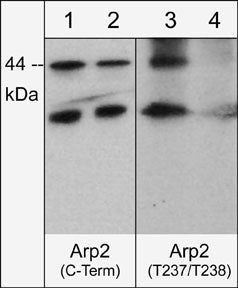Anti-Arp2 (C-terminal region) Antibody
- SPECIFICATION
- CITATIONS
- PROTOCOLS
- BACKGROUND

Application
| WB, IHC |
|---|---|
| Primary Accession | P61160 |
| Reactivity | Bovine, Chicken, Drosophila, C.Elegans |
| Host | Rabbit |
| Clonality | Rabbit Polyclonal |
| Isotype | IgG |
| Calculated MW | 44761 Da |
| Gene ID | 10097 |
|---|---|
| Other Names | ACTR2, Arp2 |
| Target/Specificity | Cellular morphology, adhesion, and motility occur through dynamic reorganization of actin-based superstructures. Actin-binding proteins are critical for regulating actin polymerization and superstructure formation. The Arp2/3 complex is an actin polymerization-inducing complex that includes Arp2, Arp3, p41-Arc, p34-Arc, p21-Arc, p20-Arc, and p16-Arc. Several nucleation promoting factors, such as WASP and coronin, regulate the activity of the Arp2/3 complex. In addition, the Arp2/3 complex may be regulated by phosphorylation of specific subunits in the complex. Arp2 has two phosphosites, Thr-237 and Thr-238, that are evolutionarily conserved, and are phosphorylated along with Tyr-202 in response to growth factor stimulation. These phosphorylation events may regulate binding to the pointed end of actin filaments, and alanine substitutions of these Arp2 phosphosites inhibit membrane protrusions. Thus, phosphorylation may be another mode of Arp2/3 complex regulation in addition to the activity of nucleation-promoting factors. |
| Dilution | WB~~1:1000 IHC~~1:100~500 |
| Format | Antigen Affinity Purified |
| Storage | Maintain refrigerated at 2-8°C for up to 6 months. For long term storage store at -20°C in small aliquots to prevent freeze-thaw cycles. |
| Precautions | Anti-Arp2 (C-terminal region) Antibody is for research use only and not for use in diagnostic or therapeutic procedures. |
| Shipping | Blue Ice |

Thousands of laboratories across the world have published research that depended on the performance of antibodies from Abcepta to advance their research. Check out links to articles that cite our products in major peer-reviewed journals, organized by research category.
info@abcepta.com, and receive a free "I Love Antibodies" mug.
Provided below are standard protocols that you may find useful for product applications.
Background
Cellular morphology, adhesion, and motility occur through dynamic reorganization of actin-based superstructures. Actin-binding proteins are critical for regulating actin polymerization and superstructure formation. The Arp2/3 complex is an actin polymerization-inducing complex that includes Arp2, Arp3, p41-Arc, p34-Arc, p21-Arc, p20-Arc, and p16-Arc. Several nucleation promoting factors, such as WASP and coronin, regulate the activity of the Arp2/3 complex. In addition, the Arp2/3 complex may be regulated by phosphorylation of specific subunits in the complex. Arp2 has two phosphosites, Thr-237 and Thr-238, that are evolutionarily conserved, and are phosphorylated along with Tyr-202 in response to growth factor stimulation. These phosphorylation events may regulate binding to the pointed end of actin filaments, and alanine substitutions of these Arp2 phosphosites inhibit membrane protrusions. Thus, phosphorylation may be another mode of Arp2/3 complex regulation in addition to the activity of nucleation-promoting factors.
If you have used an Abcepta product and would like to share how it has performed, please click on the "Submit Review" button and provide the requested information. Our staff will examine and post your review and contact you if needed.
If you have any additional inquiries please email technical services at tech@abcepta.com.













 Foundational characteristics of cancer include proliferation, angiogenesis, migration, evasion of apoptosis, and cellular immortality. Find key markers for these cellular processes and antibodies to detect them.
Foundational characteristics of cancer include proliferation, angiogenesis, migration, evasion of apoptosis, and cellular immortality. Find key markers for these cellular processes and antibodies to detect them. The SUMOplot™ Analysis Program predicts and scores sumoylation sites in your protein. SUMOylation is a post-translational modification involved in various cellular processes, such as nuclear-cytosolic transport, transcriptional regulation, apoptosis, protein stability, response to stress, and progression through the cell cycle.
The SUMOplot™ Analysis Program predicts and scores sumoylation sites in your protein. SUMOylation is a post-translational modification involved in various cellular processes, such as nuclear-cytosolic transport, transcriptional regulation, apoptosis, protein stability, response to stress, and progression through the cell cycle. The Autophagy Receptor Motif Plotter predicts and scores autophagy receptor binding sites in your protein. Identifying proteins connected to this pathway is critical to understanding the role of autophagy in physiological as well as pathological processes such as development, differentiation, neurodegenerative diseases, stress, infection, and cancer.
The Autophagy Receptor Motif Plotter predicts and scores autophagy receptor binding sites in your protein. Identifying proteins connected to this pathway is critical to understanding the role of autophagy in physiological as well as pathological processes such as development, differentiation, neurodegenerative diseases, stress, infection, and cancer.


